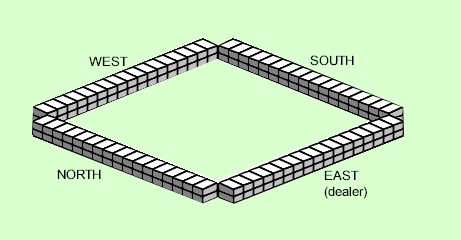
|
Hong Kong Mahjong (HKOS) |
Hong Kong Mahjong - la puntuación
HKOS - manos y valores |
|
Hong Kong Mahjong es probablemente la variación más popular de mahjong jugado en China.
Hong Kong mahjong juego y su forma es muy similar a mahjong tradicional chino. Hong Kong mahjong utiliza a una progresiva systema de puntuación con dobles (fan). Pung and kong ya no ganan puntos. En cambio, fan se ganan de acuerdo con una tabla de pagos de-abajo. Mahjong es un juego chino de destreza y de estrategia que implica generalmente a 4 jugadores. Mahjong es similar a gin rummy: el objetivo de mahjong es construir series y obtener los mas altos valores. Cada jugador de mahjong selecciona y descarta los azulejos hasta que construyen combinaciones completos. En la siguiente tabla se muestra un conjunto completo de fichas de mahjong.
|
|
El Objetivo del Hong Kong Mahjong El objetivo es ser el primer jugador en obtener una mano completa que con 4 series de tres (tres de una especie de la misma baraja "pung" o una secuencia de la misma baraja "chow" y tambien un par, para el total de 14 pedazos.
Rompiendo la Pared Los pedazos son mezclados y colocados boca abajo en la mesa y cada jugador construye una pared de 2 pedazos de alto y 17 de ancho (o 18 de ancho si jugando con Flores y Estaciones). Despuso, los jugadores combinan sus paredes individuales para formar un cuadrado como en una imagen de abajo. El juego procede hacia la izquierda: Este > Sur > Oeste > Norte. 
East throws three dice, and uses the sum of the dice to determine which side of the wall will be the starting point: count proceeds counterclockwise around the walls, starting with Eastern wall and number 1, so that numbers 5, 9, 13, and 17 would correspond to East, numbers 2, 6, 10, 14, 18 would indicate South, numbers 3, 7, 11, 15 would mean West and numbers 4, 8, 12 and 16 would indicate North). Next, starting from the right side of the indicated player's wall, East counts off stacks clockwise until dice sum is reached. After that, East takes the next two stacks (four tiles) after the last stack counted. South takes the next two stacks, West takes the next two, then North takes the next two. All players continue to take stacks in turn until each player has six stacks (12 tiles). Note: players take turns going counterclockwise, but tiles are drawn from the wall clockwise. This applies when dealing tiles and during gameplay. Each player then draws one extra tile with East drawing one last one at the end to begin with 14 tiles. Any flowers or seasons are declared and immediately placed face up to the side of the hand, and are replaced with tiles drawn from the end of the Dead Wall (where the wall was broken) in the order of East, South, West, and North. Playing Mahjong Upon discard, other players can choose to pass, or to take the tile to complete a set (pung, chow or kong - see below), or to declare a win ("mahjong"). Play begins with the dealer (East) and continues in a counter-clockwise direction A player may perform one of four actions on their turn Priority of Actions and Furiten Rule HKOS - la puntuación HKOS - - manos y valores ▲
Copyright © 2020 MahjongJoy.com Map |